|
Home > Android Phone Reviews > Motorola Droid Turbo

Motorola Droid Turbo
Editor's rating (1-5):    
Carrier: Verizon (exclusive in the US)
Manufacturer: Motorola
|
|
|
What's Hot: Fast, comfy in the hand, lovely QHD display, strong battery life with quick charging and wireless charging, clean Android set to get OS updates quickly.
What's Not: Earpiece volume is low, WiFi reception a bit below average. Given the MP rating, the camera isn't as good as we'd hoped, though it's OK in low light.

Reviewed November 6, 2014 by Lisa Gade, Editor
in Chief (twitter: @lisagade)
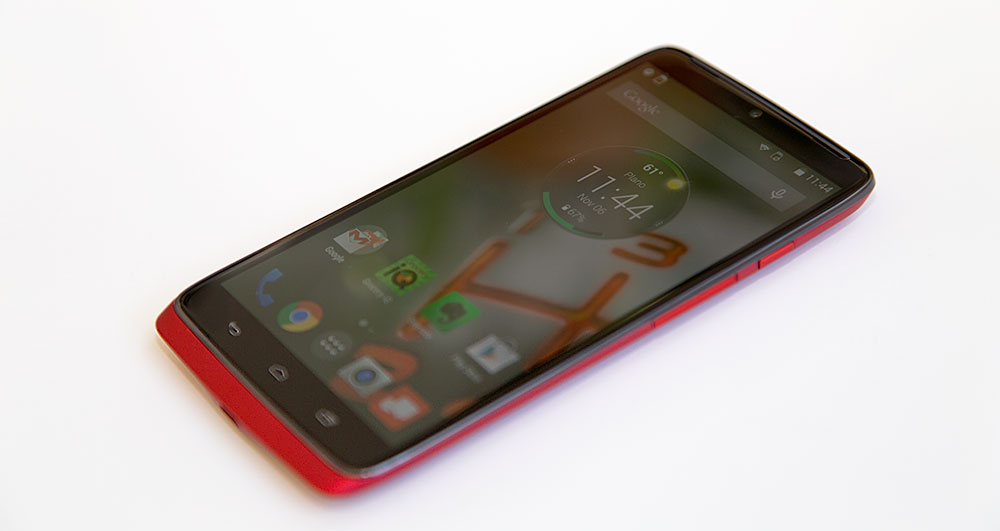
|
|
The long-lived Droid line of Android smartphones on Verizon Wireless featured angular, masculine designs, raucous screeching robot startup sounds and industrial wallpapers. Moto has evolved, and though Verizon sets the design tone, the Droid Turbo is a more modern and less ominous phone. It has Moto's recent signature curves that feel great in the hand, a very clean Android build and a warmer feel. You can still get it in eyeball popping red Kevlar or a somewhat more sedate black Kevlar, but Moto is now the master of casing materials thanks to the myriad options available with the Moto X, and there's a black ballistic nylon-backed Turbo too.
There's more to the Droid Turbo than updated looks and a cleaner OS: its specs outdo the 2014 Moto X and all flagship Android phones currently on the market except the Samsung Galaxy Note 4. The Droid Turbo and the Note 4 run on the latest, greatest Qualcomm Snapdragon 805 quad core CPU with Adreno 420 graphics, 3 gigs of RAM and 32 or 64 gigs of storage. It's called the Turbo because it comes with Moto's turbo charger in the box, and that's a charger that supports Qualcomm Quick Charge 2.0 for extreme quick charging. It has a 3900 mAh battery, which is higher than batteries in phablets like the Note 4 and iPhone 6 Plus. And then there's the QHD, 2560 x 1440 AMOLED display for incredible sharpness and strong color saturation. It makes the Moto X 2014 seem less stellar, though we understand if you still prefer the more stately design and customizable backs on the X. Like all Droids, the Turbo is exclusive to Verizon in the US, though it will be sold as the Droid Maxx in South America.
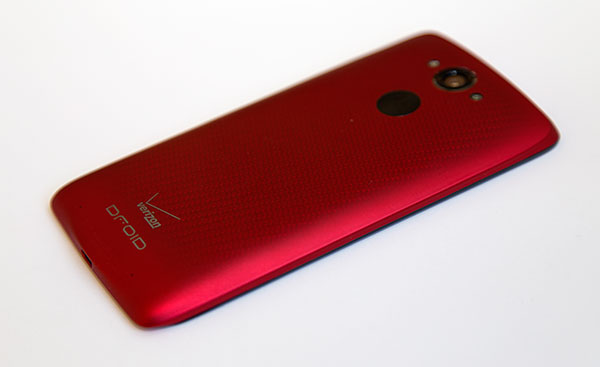
Design and Ergonomics
Given the very large battery inside, the Droid Turbo can't be as svelte as the Moto X, even if they share the same 5.2" display size. The Turbo weighs 6 ounces (6.2 ounces if you opt for the ballistic nylon back) and it's 0.31-0.42" thick. The red and black models have metalized glass fiber over Kevlar and the ballistic nylon model has Kevlar underneath. They might not stop a bullet, but they'll die trying. The Turbo models have a water repellant coating, but they're not water resistant for immersion as are the Samsung Galaxy S5 and Sony Xperia Z3v. The phone feels sturdy and rugged, and in fact it is. Gorilla Glass 3 protects the front. You might expect the ballistic nylon to be the more grippy finish, but in fact it feels pretty slick in the hand and we had an easier time with the standard smooth matte finish red and black models.
The phone's nano SIM card slot is in an unusual place: under the volume rocker. You'll pull the volume rocker out using a fingernail to access the card slot. Since most folks don't swap SIM cards often this doesn't bother us, and honestly, it's no harder to access than SIM card slots that require a paperclip to open. The volume and power buttons are on the right side, the headphone jack is up top and the micro USB 2.0 port is on the bottom. The battery is sealed inside and there's no microSD card slot. The speaker lives under a long, thin grille above the display and it doubles as the earpiece.
At 5.2", this is considered a mainstream size phone that's dwarfed by the Note 4 and iPhone 6 Plus, but it's not much smaller than the impressively compact 5.5" LG G3. The ergonomic curves feel great in the hand, and it's comfortable and easy to hold. It's a bit heavier than average thanks to the huge battery, but it's not so heavy as to feel like a burden.
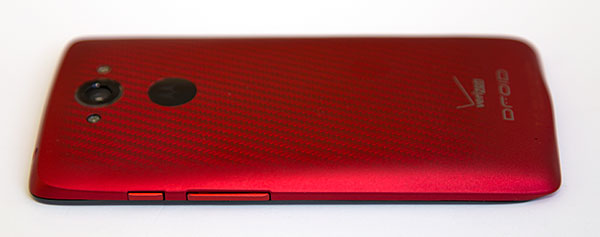
Display
There are quite a few AMOLED lovers out there, and Motorola has put a truly lovely 2560 x 1440 AMOLED display in the phone. That works out to an insane 565 PPI pixel density, and no matter how keen-eyed you are, you won't be able to discern individual pixels. Moto tuned the display to be more accurate in terms of colorcast so human skin looks warm and natural and white backgrounds don't have the blue-magenta bias we've seen on some Super AMOLED panels. It's very saturated but not over the top (as AMOLED goes), and it has AMOLED's deep blacks and near infinite contrast. If you liked the shape and resolution of the LG G3 but found its IPS LCD too dull, you'll likely be pleased with the Droid Turbo. It's brighter than the 2014 Moto X, but not as bright as the Samsung Galaxy Note 4 (and we're not talking about Samsung's insane 750 nit outdoor high brightness mode, just regular brightness levels). We had no trouble seeing the Turbo's display outdoors, though the LCD picks up and shows fingerprints more than some other phones, and those obscure the display outdoors.
|
Deals and Shopping:
Advertisement
|
|
Motorola Droid Turbo Video Review
Horsepower and Software
As you might guess, since the Moto is one of two Snapdragon 805 phones on the market, it's one of the fastest. In fact, it scored very similarly to the Galaxy Note 4 running the same CPU and the same display resolution. Honestly, the 2.7GHz quad core with Adreno 420 graphics is faster than most of us really need. But Android is all about specs wars, and since some phones run heavy overlays (Samsung and LG), no one complains about more horsepower. The Droid Turbo shows Google's influence over Motorola (they owned Motorola until a few weeks ago), and that's a good thing. We have a very clean Android AOSP version of KitKat 4.4.4 here, and the Droid Turbo is supposed to get Android 5.0 Lollipop quite soon. The clean Android experience and fast CPU mean the Turbo is a very responsive phone that doesn't bog down when switching between apps. It has 3 gigs of RAM to keep multitasking fluid, and we couldn't make the phone stutter or lag. It's obviously a great choice for serious 3D gaming and is as future proof as any smartphone can be at the moment. Of course, technology marches on quickly and there will be something even faster a year from now, but the question is: do we really need more speed? In the case of the Turbo, probably not.
The phone has 32 gigs of internal storage with 23 gigs available. There's no storage expansion, so that's all you've got. The ballistic nylon model is available with 64 gigs of storage (52 gigs free) for $50 more. That's a reasonable price for double the storage, if you need it.
Verizon includes their usual bloatware including VZ Navigator and seemingly every Amazon app available for Android. These aren't removable but you can disable and hide them using app settings if you wish. Moto includes Droid Zap for wireless transfer of photos to and from other Android phones and their excellent Moto apps like Moto Assist, Moto Voice, Moto Display and Moto Actions. These are the same great software features that we loved on the 2014 Moto X, and they make using the phone more streamlined and convenient.
|
Advertisement
|
Benchmarks
| |
Quadrant |
3DMark Ice Storm |
AnTuTu |
Sunspider JavaScript Test (lower is better) |
| Droid Turbo |
22,709 |
20,735 |
48,332 |
795 |
| Sony Xperia Z3v |
20,642 |
18,682 |
41,900 |
808 |
| Samsung Galaxy Note 4 |
24,327 |
19,667 |
46,912 |
425 |
| Samsung Galaxy Note Edge |
24,532 |
19,841 |
46,271 |
353 |
| Samsung Galaxy S5 |
23,643 |
18,329 |
35,357 |
398 |
| Moto X (2nd gen) |
22,170 |
19,924 |
44,340 |
776 |
| Moto X (first gen) |
8357 |
6800 (extreme) |
21,377 |
1097 |
| LG G3 |
24,385 |
18,708 |
36,525 |
425 |
| HTC One M8 |
24,527 |
20,896 (unlimited) |
36,087 |
776 |
| Nexus 5 |
8808 |
17,828 (unlimited) |
27,017 |
718 |
| Moto G |
8485 |
2778 (extreme) |
17,396 |
1311 |
| LG G2 |
19,762 |
9803 (extreme) |
32,990 |
823 |
| Samsung Galaxy S4 |
12,276 |
11,601 (unlimited) |
24,776 |
826 |
Geekbench 3: 1088/2960
Moto Voice, Actions, Assist and Display
Want information with little effort? Moto Display allows you to wave your hand over the display and IR sensors on the front tell the phone to show you the informative lock screen with notifications. No need to turn on the phone or even double-tap. See an email notification on the lock screen? Press and hold its icon to get a preview of the email, or swipe it up to launch the mail program with that message open.
Voice control has gotten even better, and it's a Moto custom solution, not just Google Now. You don't have to say "OK Google Now", you can say anything you want as the wake phrase, as long as it's at least 4 syllables long (their suggestion is "hi Droid Turbo"). Once you train it with your waking phrase (hint, don't use something you say all the time), all you have to do is say it, followed by what you want the phone to do. Leave it sitting on your desk or the center console of your car, sleeping: it's still listening.
Moto actions handle things like quiet time overnight, switching to driving mode where it will do things like read text messages aloud or go into meeting mode if your calendar has a meeting. For driving mode, you'll need to activate the more accurate GPS location setting.
Calling, Reception and Data
Motorola generally does well with both reception and voice quality, though their DSPs have a tendency to make the caller's voice sound slightly digitized when calling from noisy locations. The Moto Droid Turbo has good reception, and these days most phones have similar reception as measured in decibels (don't go by the bars on the top of the display, they're a bit arbitrary). That said, our office is in a weak Verizon 4G LTE neighborhood, and the Turbo managed to tenaciously hold onto LTE while the Sony Xperia Z3v occasionally dropped to 3G (both measured 113 db. or worse on LTE). The Samsung Galaxy Note 4 is the reception king if you're in a weak area and it typically had a 5 to 10 db. stronger signal, which is significant. If you're in a moderate or stronger coverage area this won't matter, but for those in fringe coverage areas, we'd say the Droid Turbo is strong but bested by the Note 4. WiFi reception on our 802.11ac network was just average, once again beaten by the Note 4. We particularly noticed that range was below average--it wasn't outright bad, but it wasn't what we'd call good.
Voice quality is very good for incoming and outgoing voice, with little of the digitization on outgoing voice that we've noted on some Motorola phones. Earpiece volume is below average, and that's compounded by the earpiece speaker being offset to the right (if you don't notice that and keep the phone centered, it's very quiet). Volume through speakerphone, headphones and Bluetooth is normal.
Camera
OK Moto, maybe now that Lenovo has bought you, they'll throw some camera engineers at your problem. Motorola phones have mediocre cameras, despite using some good hardware like the Sony sensor and fast f.2.0 lens in the Turbo's rear camera. It's not much better than the 2014 Moto X's 13MP camera, and the software has to be the weak link here. We like the UI in the camera app quite well, it's the image processing software and focus times that lag behind the better competition. In good lighting, the camera does well other than occasional autofocus mishaps, and video recording, particularly 4K, is quite good. Low light photos are definitely better than the updated Moto X, but not as good as the LG G3, Nokia Lumia Icon, Samsung Galaxy Note 4 or iPhone 6.
Battery Life
Here's the star of the show. Rather than release a Droid with a standard capacity battery and another model with a super capacity battery, Verizon's cut to the chase and released one Droid with a monstrous 3900 mAh battery that's sealed inside. That's significantly higher capacity than standard size phones or big screen phablets. Verizon claims 2 days of use on a charge, and while that's optimistic, we averaged 1.5 days with moderate to somewhat heavy use. The screen is a big consumer of power, so we stuck with auto-brightness, which we found adequate. If you spend hours playing 3D games or navigating with the GPS, runtimes will of course be shorter, but for the average day with calls, web, email, messaging and streaming a half hour video, the Turbo is hard to kill.
Conclusion
If you want the best specs, a killer battery and clean Android experience with relatively quick OS updates in a phone that's not huge like the Nexus 6, it's hard to beat the Motorola Droid Turbo. Though it's not as beautiful as the 2014 Moto X and you can't order one with a walnut or leather back, it's actually a good looking phone and it's sturdy too. Of course, nothing is perfect and the camera is OK but not as fantastic as you might think from the specs, and WiFi reception is ho-hum.
Price: $199 with contract, $599 retail for 32 gig. 64 gig is $50 additional.
Websites: www.verizonwireless.com, www.motorola.com
Related Reviews:
Samsung Galaxy S6 & Galaxy S6 Edge Review
LG G3 Review
2014 Moto X Review
Sony Xperia Z3v Review
Samsung Galaxy Note 4 Review
Samsung Galaxy S5 Review
iPhone 6 Review
iPhone 6 Plus Review |
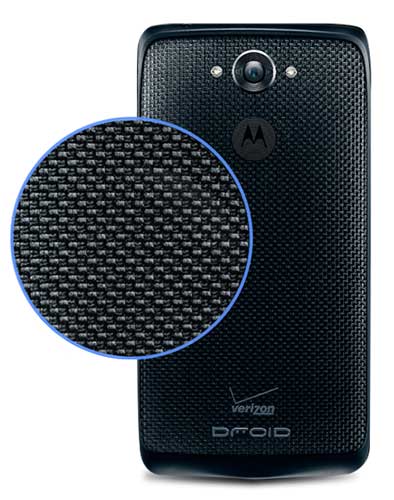
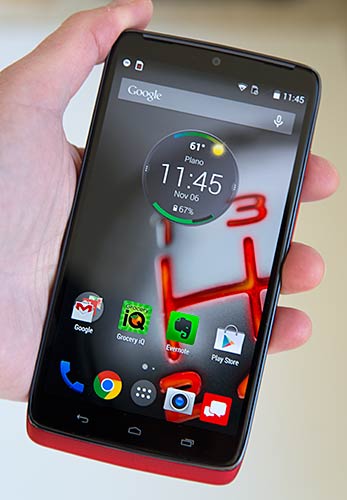


|
Specs:
|
Display: 5.2" AMOLED display. Resolution:
QHD 2560 x 1440. Has ambient light sensor, IR sensor for Moto Display, accelerometer and proximity sensor.
Battery: 3900 mAh Lithium
Ion Polymer rechargeable. Battery is not user replaceable. Turbo charger included.
Performance: 2.7GHz Qualcomm Snapdragon 805 quad core CPU with Adreno 420 graphics. 3 gigs RAM, 32 or 64 gigs storage.
Size: 5.65
x 2.89 x 0.44 (thickest point) inches. Weight: 6 or 6.2 ounces (ballistic nylon is heavier).
Phone: CDMA dual band digital, EV-DO Rev. A 3G and 4G LTE. GSM world roaming, quad band HSPA+, LTE on bands 2, 3, 4, 7, 13. Uses a nano SIM card.
Camera: 2MP front camera and rear 21MP camera with HDR, dual LED flash and f/2.0 lens. Can shoot 4K video at 24 fps.
Audio: Built
in speaker, mic and 3.5mm standard stereo headphone
jack.
Networking: Integrated dual band
WiFi 802.11b/g/n/ac, NFC and Bluetooth 4.0.
Software: Android OS 4.4.4 KitKat. Droid Zap, Moto Assist, Moto Display, Moto Actions and Moto Voice. Usual selection of Verizon bloatware including VZ Navigator and Amazon bundled apps.
Expansion: none.
|
|
|

